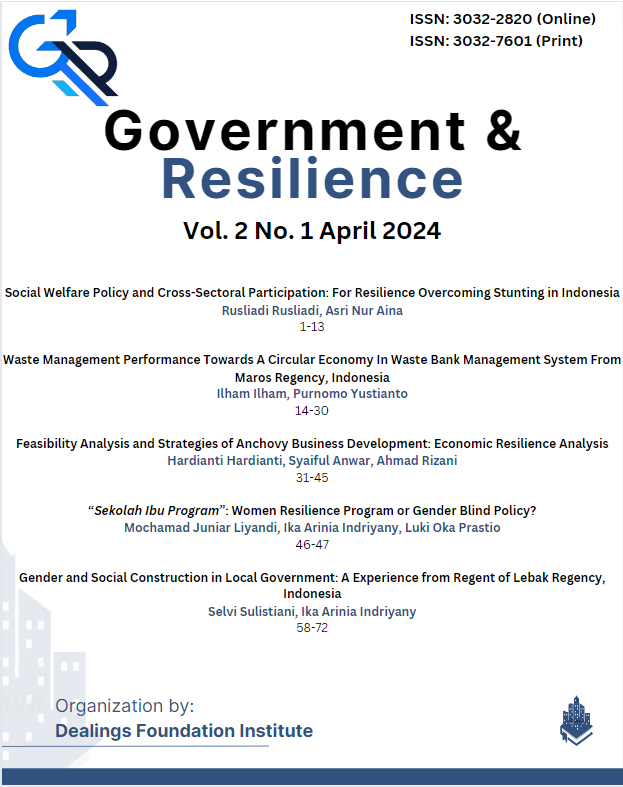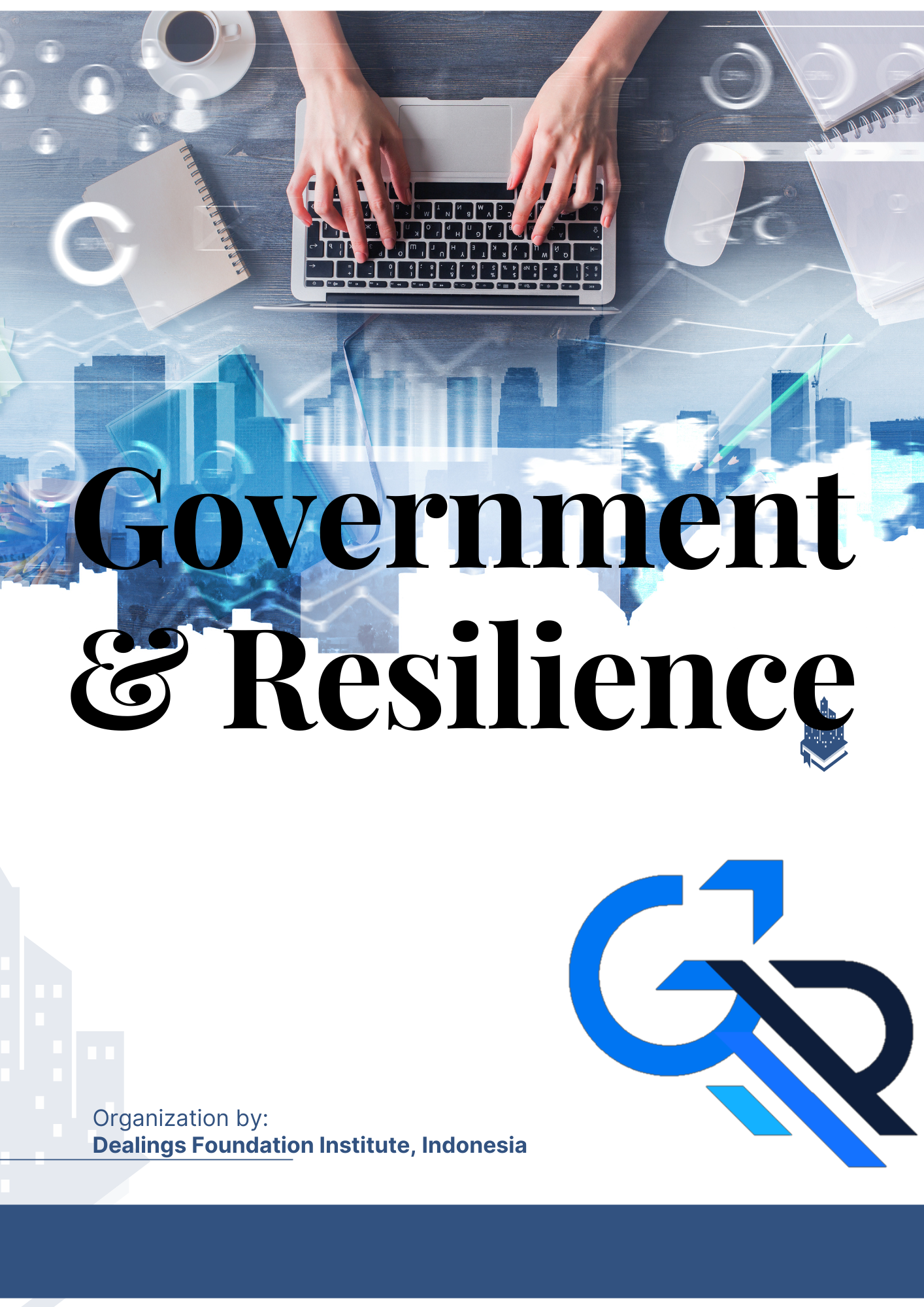Social Welfare Policy and Cross-Sectoral Participation: For Resilience Overcoming Stunting in Indonesia
DOI:
https://doi.org/10.62503/gr.v2i1.10Keywords:
Poverty Alleviation Program, Stunting, Cross-Sector Participation, Social Policy, MilitaryAbstract
Efforts to reduce poverty must have an impact that can reach the various problems caused by poverty. This research aims to analyze social policies related to poverty alleviation and cross-sectoral participation in overcoming stunting problems that occur in Indonesia. This research uses a qualitative-exploratory research method to examine the Government's Social Policy in overcoming poverty and its impact on stunting which involves cross-sector participation in its implementation. Then the data is collected from interviews, field observations, and applicable literature, then to analyze the results using Nvivo 12 Pro. The location of this research uses a regional case study in Indonesia, namely the Bantaeng Regency area. The results of this study show that the contribution of government social policies in overcoming poverty has a very positive impact on reducing the number of stunting that occurs in Bantaeng Regency. Several programs issued by the government focus on increasing consumption and fulfilling community nutrition by assisting with food. Then cross-sectoral participation in handling stunting in Bantaeng Regency has also been going well, because it not only involves the local government but also involves the military. However, this study found that there was a lack of involvement of the private sector in efforts to help the government deal with the problem of stunting. So that this is a weakness in handling stunting, therefore in handling stunting based on government programs there needs to be a binding regulation to involve the private sector.
References
Apriantoro, M. S., Rahayuningsih, I. N., & Sarwanto, S. (2022). Implementation of Green Economy Through Integrated Urban Farming as Family Economic Resilience During The Pandemic: Maqasid Sharia Perspective. Jurnal Ekonomi. https://doi.org/10.54471/iqtishoduna.v11i1.1593
Babu, S., Gajanan, S., & Sanyal, P. (2014). Food security, poverty and nutrition policy analysis: statistical methods and applications. Academic Press.
Fitri, I. A. (2019). Penanggulangan Gelandangan Dan Pengemis Di Indonesia (Analisis Program Desaku Menanti di Kota Malang, Kota Padang dan Jeneponto). Share : Social Work Journal, 9(1), 1. https://doi.org/10.24198/share.v9i1.19652
Galvin, R., & Healy, N. (2020). The Green New Deal in the United States: What it is and how to pay for it. Energy Research & Social Science, 67, 101529. https://doi.org/10.1016/j.erss.2020.101529
Gibson, J., & Olivia, S. (2020). Direct and Indirect Effects of Covid-19 On Life Expectancy and Poverty in Indonesia. Bulletin of Indonesian Economic Studies, 56(3), 325–344. https://doi.org/10.1080/00074918.2020.1847244
Giurge, L. M., Whillans, A. V., & West, C. (2020). Why time poverty matters for individuals, organisations and nations. Nature Human Behaviour, 4(10), 993–1003. https://doi.org/10.1038/s41562-020-0920-z
Grindle, M. S. (2004). Good Enough Governance: Poverty Reduction and Reform in Developing Countries. Governance, 17(4), 525–548. https://doi.org/10.1111/j.0952-1895.2004.00256.x
Haddad, L. J., Hawkes, C., Achadi, E., Ahuja, A., Ag Bendech, M., Bhatia, K., ... & Flores-Ayala, R. (2015). Global Nutrition Report 2015: Actions and accountability to advance nutrition and sustainable development. Intl Food Policy Res Inst.
Hatimah, I., & Lutfiansyah, D. Y. (2021). Community Empowerment Synergy Model based on Parenting Programs in Reducing Numbers of Stunting in Cirebon Regency. International Journal of Early Childhood Special Education, 13(2), 1130–1137. https://doi.org/10.9756/INT-JECSE/V13I2.211158
Indra, J., & Khoirunurrofik, K. (2022). Understanding the role of village fund and administrative capacity in stunting reduction: Empirical evidence from Indonesia. PLOS ONE, 17(1), e0262743. https://doi.org/10.1371/journal.pone.0262743
Jauhar, M., Indanah, I., Kartikasari, F., & ... (2022). Community Health Volunteer Up skilling Increase Community-Based Stunting Early Detection Knowledge. Jurnal …. http://jkp.poltekkes-mataram.ac.id/index.php/home/article/view/768
Kementerian Kesehatan RI. (2023). Prevalensi Stunting di Indonesia Turun ke 21,6% dari 24,4%. Kementerian Kesehatan RI. https://sehatnegeriku.kemkes.go.id/baca/rilis-media/20230125/3142280/prevalensi-stunting-di-indonesia-turun-ke-216-dari-244/#:~:text=Kementerian Kesehatan mengumumkan hasil Survei,21%2C6%25 di 2022.
Kodish, S. R., Farhikhtah, A., Mlambo, T., Hambayi, M. N., Jones, V., & Aburto, N. J. (2022). Leveraging the Scaling Up Nutrition Movement to Operationalize Stunting Prevention Activities: Implementation Lessons From Rural Malawi. Food and Nutrition Bulletin, 43(1), 104–120. https://doi.org/10.1177/03795721211046140
Liu, M., Feng, X., Wang, S., & Qiu, H. (2020). China’s poverty alleviation over the last 40 years: successes and challenges. Australian Journal of Agricultural and Resource Economics, 64(1), 209–228. https://doi.org/10.1111/1467-8489.12353
Loosemore, M., Denny-Smith, G., Barraket, J., Keast, R., Chamberlain, D., Muir, K., Powell, A., Higgon, D., & Osborne, J. (2021). Optimising social procurement policy outcomes through cross-sector collaboration in the Australian construction industry. Engineering, Construction and Architectural Management, 28(7), 1908–1928. https://doi.org/10.1108/ECAM-04-2020-0221
Mensi, A., & Udenigwe, C. C. (2021). Emerging and practical food innovations for achieving the Sustainable Development Goals (SDG) target 2.2. Trends in Food Science & Technology, 111, 783-789. https://doi.org/10.1016/j.tifs.2021.01.079
Mhlanga, D. (2021). Artificial Intelligence in the Industry 4.0, and Its Impact on Poverty, Innovation, Infrastructure Development, and the Sustainable Development Goals: Lessons from Emerging Economies? Sustainability, 13(11), 5788. https://doi.org/10.3390/su13115788
Miles Matthew, B., Michael, H. A., & Johnny, S. (2014). Qualitative data analysis: A methods sourcebook. Sage Publications.
Mintrom, M., & Thomas, M. (2018). Policy entrepreneurs and collaborative action: Pursuit of the sustainable development goals. International Journal of Entrepreneurial Venturing, 10(2), 153-171. https://doi.org/10.1504/IJEV.2018.092710
Munawir, Madani, M., Fatmawati, & Parawu, H. E. (2019). Implementasi Kebijakan Penanggulangan Kemiskinan(Studi Kasus Program Kube-Fm Dinas Sosial Dan Ketenagakerjaan Kabupaten Bantaeng). Journal of Public Policy and Management, 1(2), 88–97.
Nursam. (2021). Tekan Angka Kemiskinan, Bantaeng Kejar Target 7,40 Persen. FAJAR.CO.ID. https://sulsel.fajar.co.id/2021/08/26/tekan-angka-kemiskinan-bantaeng-kejar-target-740-persen/
Patha, N. (2022). BKKBN Launching Dapur Sehat Atasi Stunting di Bantaeng. Kabarmakassar.Com. https://www.kabarmakassar.com/posts/view/20584/bkkbn-launching-dapur-sehat-atasi-stunting-di-bantaeng.html
Pratiwi, D. C., & Imsar, I. (2022). Analisis penyaluran bantuan sosial program keluarga harapan (PKH) dan bantuan pangan non tunai (BPNT) dinas sosial pada masyarakat Kabupaten Batu Bara. Fair Value: Jurnal Ilmiah Akuntansi Dan …. http://journal.ikopin.ac.id/index.php/fairvalue/article/view/2122
Purwandiyah, H. (2017). Implementasi Program Keluarga Berencana Dalam Pembangunan Keluarga Sejahtera (Studi di Kec. Telen Kabupaten Kutai Timur, Propinsi Kalimantan Timur). Jurnal Paradigma (JP). http://e-journals.unmul.ac.id/index.php/JParadigma/article/view/348
Razak, A. A., Muhammad, F., Hussin, M. Y. M., Zainol, Z., & ... (2017). The Role of Ar-Rahn in Enhancing Financial Inclusion: A Structural Equation Modeling Approach. In Jurnal …. ir.upsi.edu.my. https://ir.upsi.edu.my/files/docs/2020/3793_3793.pdf
Rojas, M. (2015). Poverty and People’s Wellbeing. In Global Handbook of Quality of Life (pp. 317–350). Springer Netherlands. https://doi.org/10.1007/978-94-017-9178-6_14
Rokx, C., Subandoro, A., & Gallagher, P. (2018). Aiming high: Indonesia's ambition to reduce stunting. https://hdl.handle.net/10986/30151
Sachs, J. D. (2006). The end of poverty: Economic possibilities for our time. Penguin.
Sartika, S. (2021). Analisis Efektivitas Program Keluarga Harapan dalam Pengentasan Kemiskinan (Studi pada Peserta PKH Kelurahan Bonto Rita Kecamatan Bissappu Kabupaten …. http://repositori.uin-alauddin.ac.id/22425/%0Ahttp://repositori.uin-alauddin.ac.id/22425/1/90300116061 SARTIKA.pdf
Scheyvens, R., Banks, G., & Hughes, E. (2016). The private sector and the SDGs: The need to move beyond ‘business as usual’. Sustainable Development, 24(6), 371-382. https://doi.org/10.1002/sd.1623
Singh, H. P., Singh, A., Alam, F., & Agrawal, V. (2022). Impact of Sustainable Development Goals on Economic Growth in Saudi Arabia: Role of Education and Training. Sustainability, 14(21), 14119. https://doi.org/10.3390/su142114119
Sopiah, A. (2023). BPS: Garis Kemiskinan 2022 Tertinggi dalam 9 Tahun Terakhir. CNBC Indonesia. https://www.cnbcindonesia.com/news/20230117155630-4-406179/bps-garis-kemiskinan-2022-tertinggi-dalam-9-tahun-terakhir
Subramanian, S. V., Mejía‐Guevara, I., & Krishna, A. (2016). Rethinking policy perspectives on childhood stunting: time to formulate a structural and multifactorial strategy. Maternal & child nutrition, 12, 219-236. https://doi.org/10.1111/mcn.12254
Sumner, A., Ortiz-juarez, E., & Hoy, C. (2020). Precarity and the pandemic : COVID-19 and poverty incidence , intensity , and severity in developing countries WIDER Working Paper 2020 / 77 Precarity and the pandemic COVID-19 and poverty incidence , intensity , and severity in developing countries.
Wicaksono, F., & Harsanti, T. (2020). Determinants of stunted children in Indonesia: A multilevel analysis at the individual, household, and community levels. Kesmas: Jurnal Kesehatan …. https://www.journal.fkm.ui.ac.id/kesmas/article/view/2771
Widianingsih, I., & Paskarina, C. (2019). Defining Inclusiveness in Development: Perspective from Local Government’s Apparatus. Jurnal Bina Praja: Journal of …. http://jurnal.kemendagri.go.id/index.php/jbp/article/view/567
Woolf, N. H., & Silver, C. (2018). Qualitative Analysis Using Nvivo, The Five Level QDA Method. In Routledge. New York and London: Routledge.
Xu, L., Zhang, Q., & Shi, X. (2019). Stakeholders strategies in poverty alleviation and clean energy access: A case study of China’s PV poverty alleviation program. Energy Policy, 135, 111011. https://doi.org/10.1016/j.enpol.2019.111011
Vartanian, T. P. (2010). Secondary data analysis. Oxford University Press.
Downloads
Published
How to Cite
Issue
Section
License
Copyright (c) 2024 Government & Resilience

This work is licensed under a Creative Commons Attribution-NonCommercial-ShareAlike 4.0 International License.
1. Licence
Use of articles will be governed by the Creative Commons Attribution-NonCommercial-ShareAlike 4.0 International license as currently displayed on the Creative Commons Attribution-NonCommercial-ShareAlike 4.0 International License (CC BY-NC-SA 4.0).
2. Author(s)' Warranties
The author warrants that the article is original, written by the stated author(s), has not been published before, contains no unlawful statements, does not infringe the rights of others, is subject to copyright that is vested exclusively in the author and free of any third-party rights, and that any necessary written permissions to quote from other sources have been obtained by the author(s).
3. User Rights
The spirit of Government & Resilience is to disseminate articles published as freely as possible. Under the Creative Commons license, Government & Resilience permits users to copy, distribute, display, and perform the work. Users will also need to attribute authors and Government & Resilience for distributing works in journals and other media of publication.
4. Rights of Authors
Authors retain all their rights to the published works, such as (but not limited to) the following rights:
1. Copyright and other proprietary rights relating to the article, such as patent rights,
2. The right to use the substance of the article in future works, including lectures and books,
3. The right to reproduce the article for own purposes,
4. The right to enter into separate, additional contractual arrangements for the non-exclusive distribution of the article's published version (e.g., post it to an institutional repository or publish it in a book), with an acknowledgment of its initial publication in this journal (Government & Resilience).
5. Co-Authorship
If the article was jointly prepared by more than one author, any author submitting the manuscript warrants that he or she has been authorized by all co-authors to agree on this copyright and license notice (agreement) on their behalf and agrees to inform his or her co-authors of the terms of this policy. Government & Resilience will not be held liable for anything that may arise due to the author's internal dispute. Government & Resilience will only communicate with the corresponding author.
6. Royalties
Being an open-access journal and disseminating articles for free under the Creative Commons license term mentioned, the author(s) are aware that Government & Resilience entitles the author(s) to no royalties or other fees.











